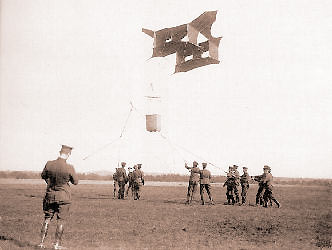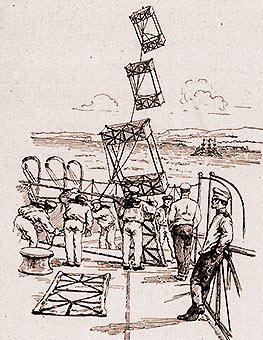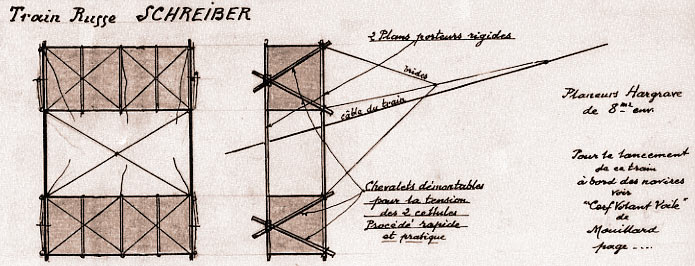| |
| Captain Saconney, in a report about military kites, explains that aerial observations are a requirement of modern warfare. He emphasizes the choice of the German and Austrian armies to use balloon kites, as well as the path chosen by the English and Russians, towards mounted kites. |
| |
|
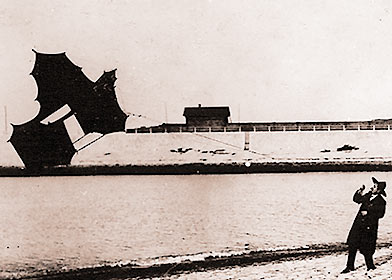 |
Samuel Franklin Cody, an American entertainer and lasso thrower, buys to his son a kite derived the Hargrave models. It transforms this device by adding side wings.
His system interest the English army that recruits him in 1894. Then he follows closely experiments on different models.
He develops, in 1901, a kite Hargrave improved by adding stabilizing wings and growing cells. He filed a patent for a kite which associated as a train would raise a man, carrying weapons, eyeglasses or cameras.
November 7, 1903 Cody crossed the English Channel from Calais to Dover in a small boat towed by his kite. (photo left: Samuel Cody with his kite).
1906, in England, the War Office officially adopts Cody's system. The kite enters final testing with the Army. The Army provides a "1000 Frs" yearly allocation to train the men to use this new type of material.
The Blue Party, during maneuvers in the south of England, had them available for their observation service. |
| |
| At that time, the English army makes the use of kite trains mandatory to lift the observers. The kites are built so they can be used from wind speeds of 8m/s to 30m/s (storm wind). |
| |
|
|
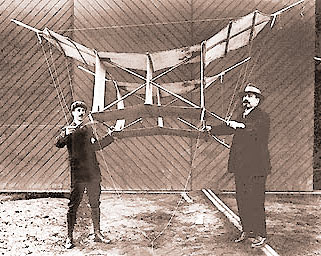 |
All companies are equipped with both kites and tethered balloons.
The English officers improve their rigging thanks to Cody's new kite types.
The Cody system is designed this way :
a first kite, the "Pilot Kite", is sent to a high altitude, followed by a train of four kites; the "Lifting Kites", all linked to the same cable. Finally, a larger one, the "Man Carrier Kite", sustains the nacelle and allows the passenger to travel up and down along the cable, just like a cable car.
A lever allows the aeronaut to control the ascension, descent or stop the movement of the nacelle along the cable. |
|
| |
| Upon reaching the observation altitude (400 to 600 meters) the aeronaut brakes to slow down and stops the system. In 1908, Cody persuades the Army to lend him the French engine Antoinette. The soldiers will call his new motorized airplane kite the flying cathedral. Despite his successful attempts in October of that year, the imperial defense committee (aerial navigation) decides that aeroplanes have no military value. |
| |
| Extract from "Cerfs-volants militaires" (military kites) of J. TH. Saconney, Engineering Captain : "Russia and England used, as soon as 1903, trains of kites in the Navy and Army. In Russia, the departments of Marine and War study the question of mounted kites since a long time. In the Army, each kite is independent and fixed to the main cable with a special Twine. In the Navy, the leading kite is independent at the top of a 25 meter special twine. The others are fixed directly on the main cable that runs through them." The coupling Baden-Powell was adopted in Russia. |
| |
|
|
| |
| The Russian Navy's kite, called Schreiber, is a Hargrave type cellular. The lifting area of this model is 7.75 square meters and it weighs 14 kilos. All spars are made of first quality white bamboo. The cells are made of cotton canvas and the bridles made of steel. Above all, they must display a great resilience.The train is composed of a head kite and six carriers kites, providing a total of 54 square meters. Stored, the kites are set one on top of the other and use very little space. |
| |
Ship lieutenant Bolscheff, of the Russian Naval Ballooning, who attended tests of the Schreiber kite in 1902, criticized the way they were used :
"While the cable is uncoiled, kites stand very badly" "The nacelle jerks and swings from side to side with such a force that the passenger must hold to something to protect himself from the jolts. The observer feels a penetrating cold, a strong shearing wind that generates tears in the eyes, preventing any observation".
Faithful balloon pilot, he has difficulty to admit the introduction of kites in Russian Navy. His narrative of ascent is certainly pushed to black, because if the sensations were so rude (especially the rise), how do you explain the many ascents made by the Russian officers, by our naval attache, Cuverville, and finally ladies, including Mrs Schreiber?
Indeed, the observations of ship lieutenant Cuverville, Naval correspondent with St-Petersburg, are very different: "The results of Mr. Schreiber's research are remarkable. This system proved reliable and can be integrally adopted. It is rigged in six minutes and eight minutes are necessary to take it down and disassemble. Flight steadiness and balance are achieved with hoists and elastic brakes, personal idea of Mr. Schreiber". |
| |
|



